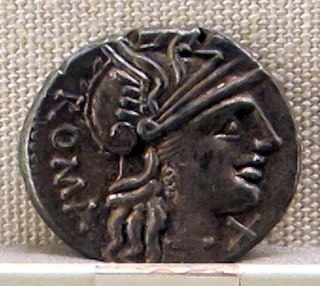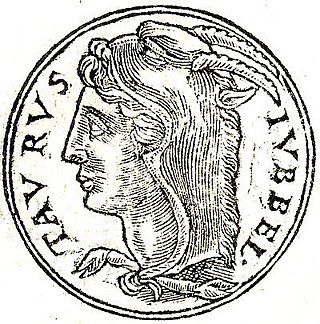Related Research Articles

The gens Petronia was a plebeian family at ancient Rome. This gens claimed an ancient lineage, as a Petronius Sabinus is mentioned in the time of Lucius Tarquinius Superbus, the last of the Roman kings, but few Petronii are mentioned in the time of the Republic. They are frequently encountered under the Empire, holding numerous consulships, and eventually obtaining the Empire itself during the brief reign of Petronius Maximus in AD 455.
The gens Pontia was a plebeian family at ancient Rome. Few members of this gens rose to prominence in the time of the Republic, but the Pontii flourished under the Empire, eventually attaining the consulship. Pontius Pilatus, as prefect of Judaea, is known for his role in the execution of Jesus.

The gens Marcia, occasionally written Martia, was one of the oldest and noblest houses at ancient Rome. They claimed descent from the second and fourth Roman Kings, and the first of the Marcii appearing in the history of the Republic would seem to have been patrician; but all of the families of the Marcii known in the later Republic were plebeian. The first to obtain the consulship was Gaius Marcius Rutilus in 357 BC, only a few years after the passage of the lex Licinia Sextia opened this office to the plebeians.
The gens Terentia was a plebeian family at ancient Rome. Dionysius mentions a Gaius Terentius Arsa, tribune of the plebs in 462 BC, but Livy calls him Terentilius, and from inscriptions this would seem to be a separate gens. No other Terentii appear in history until the time of the Second Punic War. Gaius Terentius Varro, one of the Roman commanders at the Battle of Cannae in 216 BC, was the first to hold the consulship. Members of this family are found as late as the third century AD.

The gens Minucia was an ancient Roman family, which flourished from the earliest days of the Republic until imperial times. The gens was apparently of patrician origin, but was better known by its plebeian branches. The first of the Minucii to hold the consulship was Marcus Minucius Augurinus, elected consul in 497 BC.

The gens Vibia was a plebeian family at ancient Rome. Although individuals named Vibius appear in history during the time of the Second Punic War, no members of this gens are found at Rome until the final century of the Republic. The first of the Vibii to obtain the consulship was Gaius Vibius Pansa in 43 BC, and from then until imperial times the Vibii regularly filled the highest offices of the Roman state. The emperors Trebonianus Gallus and Volusianus each claimed descent from the family.
The gens Accia was a plebeian family at ancient Rome during the late Republic. The gens is known primarily from two individuals, Lucius Accius, a tragic poet of the second century BC, and Titus Accius, best known for his prosecution of Aulus Cluentius Habitus in Cicero's oration Pro Cluentio. Other Accii are known from inscriptions.
The gens Acutia was a minor plebeian family at Ancient Rome. Members of this gens are mentioned from the early Republic to imperial times. The first of the Acutii to achieve prominence was Marcus Acutius, tribune of the plebs in 401 BC.
The gens Cluvia was a plebeian family at ancient Rome, known from the later Republic, and early imperial times. The first member of the gens to achieve prominence was Gaius Cluvius Saxula, praetor in 175 and 173 BC.

The gens Sergia was a patrician family at ancient Rome, which held the highest offices of the Roman state from the first century of the Republic until imperial times. The first of the Sergii to obtain the consulship was Lucius Sergius Fidenas in 437 BC. Despite long and distinguished service, toward the end of the Republic the reputation of this gens suffered as a result of the conspiracy of Catiline.

The gens Considia was a plebeian family at ancient Rome. The Considii came to prominence in the last century of the Republic, and under the early Empire, but none of them rose any higher than the praetorship.
The gens Egnatia was a plebeian family of equestrian rank at ancient Rome. Only a few of the Egnatii held any magistracies, of whom the most important may have been Gnaeus Egnatius, who held the praetorship during the second century BC, and served as governor of Macedonia, shortly after its institution as a Roman province.
The gens Precia was a minor plebeian family of equestrian rank at ancient Rome. Members of this gens are first mentioned toward the end of the Republic.
The gens Remmia, occasionally written Remia, was an obscure plebeian family at ancient Rome. Only a few members of this gens are mentioned in history, of whom the most illustrious was the grammarian Quintus Remmius Palaemon, but many others are known from inscriptions.
The gens Rubria was a plebeian family at ancient Rome. Members of this gens are first mentioned in the time of the Gracchi, but they did not rise to prominence until imperial times. The first of the Rubrii to obtain the consulship was Rubrius Gallus, some time before AD 68.
The gens Rupilia, occasionally written Rupillia, was a minor plebeian family at ancient Rome. Members of this gens are first mentioned in the latter part of the Republic, and Publius Rupilius obtained the consulship in 132 BC. Few others achieved any prominence, but the name occurs once or twice in the consular fasti under the Empire. The name is frequently confounded with the similar Rutilius.
The gens Statia was a minor plebeian family at ancient Rome. Members of this gens are first mentioned in the early decades of the Republic, but the name does not appear again in history until the time of Cicero. The Statii remained relatively undistinguished until the reign of Trajan, when Lucius Statius Aquila was raised to the consulship.

The gens Statilia was a plebeian family of Lucanian origin at ancient Rome. Members of this gens are first mentioned in the third century BC, when one of them led the Lucanian assault on the city of Thurii, and another commanded an allied cavalry troop during the Second Punic War; but at Rome the Statilii first come to attention in the time of Cicero, at which point they held equestrian rank. The first of the family to attain the consulship was Titus Statilius Taurus in 37 BC, and his descendants continued to fill the highest offices of the Roman state until the time of Marcus Aurelius.
The gens Titinia was a minor plebeian family at ancient Rome. Members of this gens are mentioned as early as the time of the decemvirs, but only a few held any magistracies, and none of them ever attained the consulship.
The gens Tedia or Teidia was a minor plebeian family at ancient Rome. Only a few members of this gens are mentioned in history, but they had reached senatorial rank by the first century BC, and Sextus Tedius Valerius Catullus attained the consulship in AD 31. Other Tedii are known from inscriptions.
References
- 1 2 3 Dictionary of Greek and Roman Biography and Mythology, vol. I, p. 815 ("Cominia Gens").
- ↑ Valerius Maximus, De Nom. Rat.
- ↑ Chase, p. 150.
- ↑ Petersen, "The Numeral Praenomina of the Romans", p. 348 (note 4).
- 1 2 PW, "Cominius", No. 10.
- 1 2 Edward Bunbury, "Aurunci", in Dictionary of Greek and Roman Geography, vol. I, p. 343.
- ↑ Chase, pp. 113, 114.
- ↑ Plutarch, Parallela Minora, 34.
- ↑ PW, "Cominius", No. 23.
- ↑ Livy, ii. 18, 33.
- ↑ Dionysius, v. 50, vi. 49.
- ↑ PW, "Cominius", No. 16.
- ↑ Livy, v. 46.
- ↑ Plutarch, "The Life of Camillus", 25.
- ↑ Livy, viii. 30.
- ↑ PW, "Cominius", No. 7.
- ↑ Valerius Maximus, vi. 1. § 11.
- ↑ Dionysius, xvi. 4.
- ↑ PW, "Cominius", No. 2.
- ↑ CIL IX, 439.
- ↑ PW, "Cominius", No. 12.
- ↑ Appian, Hispanica, 43.
- ↑ Cicero, In Verrem, iv. 10.
- ↑ PW, "Cominius", No. 14.
- ↑ Cicero, Pro Cluentio, 36; Brutus, 78.
- ↑ Asconius Pedianus, In Ciceronis Pro Milone.
- 1 2 PW, "Cominius", Nos. 4, 8.
- ↑ Cicero, Pro Cluentio, 36.
- ↑ Caesar, De Bello Africo, 44, 46.
- ↑ PW, "Cominius", No. 13.
- ↑ Frontinus, De Aquaeductu, 99.
- ↑ PW, "Cominius", No. 9.
- 1 2 Tacitus, Annales, iv. 31.
- ↑ PW, "Cominius", No. 5.
- ↑ PW, "Cominius", No. 21.
- ↑ CIL V, 4129.
- ↑ PW, "Cominius", No. 15.
- ↑ PW, "Cominius", No. 6.
- ↑ Eck, "Die Fasti consulares der Regierungszeit des Antoninus Pius", p. 76.
- ↑ PW, "Cominius", No. 22.
- ↑ AE 1981, 400.
- ↑ PW, "Cominius", No. 17.
- ↑ CIL V, 8659.
- ↑ AE 1890, 151.
- ↑ Alföldy, "Römische Statuen in Venetia et Histria", 85, 125, 126.
- ↑ PW, "Cominius", No. 19.
- ↑ CIL XIV, 3626.
- ↑ PW, "Cominius", No. 20.
- ↑ CIL II, 1085.
- ↑ PW, "Cominius", No. 24.
- ↑ CIL IX, 2336.
- ↑ PW, "Cominius", No. 26.